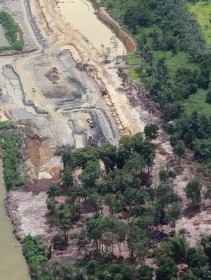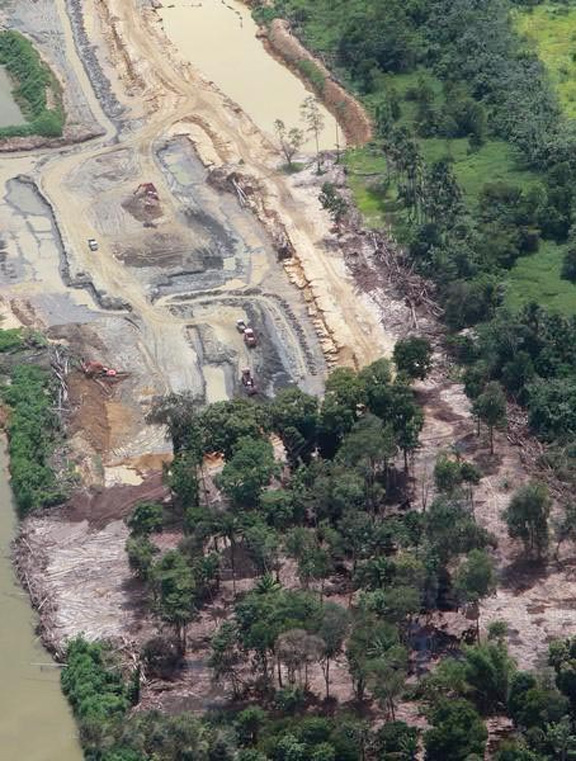As is currently the case in Guyana, record gold prices have reportedly swelled the ranks of small-scale gold mining operations in neighbouring Suriname, bringing them under increasing official scrutiny over allegations that the current ‘gold rush’ is cutting a swathe through the former Dutch colony’s tropical rainforest.

Recently an Associated Press (AP) report noted a warning by Vice-President of Suriname’s newly-elected government Robert Ameerali that the authorities may be set to reduce the use of mercury in the gold-mining industry, which, though illegal is widely available to Surinamese miners.
Allegations of excessive and irresponsible use of mercury and its impact on the poisoning of rivers and streams also abound in the mining sector in Guyana and a debate over the future use of mercury here has already started ahead of the imminent banning of mercury exports by both Europe and the United States.
As is also the case in Guyana, blame for the creation of huge clearings in the jungle surrounded by mountains of overturned soil and felled trees in Suriname is being laid at the feet of the small miners—an estimated 14,000 of them—who last year produced a record 16.5 metric tonnes of gold. The Toronto-based IAMGOLD, which once ran the single largest gold-mining operation in Guyana’s history, owns Suriname’s largest gold mine. Last year, the mine produced nearly 12 metric tonnes of gold.
Large gold-mining operations are not without their critics, but it is the small mining operations that are attracting most of the attention from environmentalists. It is the lucrative nature of the industry that has reportedly caused the government in Paramaribo to turn a blind to the illegal but reportedly rampant sub-letting of mining and what a World Wildlife Fund (WWF) official has been quoted as saying has been the tearing up of trees, poisoning of creeks with mercury and erecting of makeshift jungle towns complete with shops, prostitutes and churches. “Some parts of Suriname have become like the Wild West, only with All Terrain Vehicles and satellite dishes,”

AP reporter Ben Fox says. Fox, one of a number of AP journalists who recently visited a mining area about 100 miles south of Paramaribo writes: “All around were the huge telltale piles of discarded soil and open pits. In the middle of a network of trails was a town of sorts. The one-street settlement – more of an outpost in the jungle – was a dusty clearing and a line of simple plywood structures. There were two markets, two churches and four bars, festooned with Brazilian flags. In the lull of a rainy afternoon bored prostitutes sat watching TV until the customers returned. Plastic bottles, beer cans and other trash were strewn about everywhere or smoldering in burning piles.”
Like Guyana, Suriname has benefited from upgraded technology in the gold industry. In a matter of days, a handful of men employing high-pressure water hoses and high-priced earth removers can eradicate an entire swathe of rainforest in search of gold. Here in Guyana, fears that a similar pattern might hopelessly compromise the country’s domestic and international environmental commitments has compelled government to impose new rules which compel miners to pursue prior exploration before beginning gold exploration operations and providing government with six months notice of intention to pursue gold mining on an interior claim.
The situation in Suriname is a relatively recent development. Time was when official insistence on placing limits on logging and exempting large areas from logging and mining activity had set the country apart from other gold-mining territories in South America. Poverty and the price of gold have changed all that. A recent AP report says that satellite analysis indicates that miners in Suriname have destroyed around 74,000 acres of forest and damaged around 1,370 miles of river over the past ten years. At the same time, the WWF estimates that small scale mining is responsible for around 20 tonnes of mercury entering the environment.
Contiguous land borders have created close and often counterproductive relationships between and among Guyanese, Surinamese, Brazilian and Venezuelan miners. Here in Guyana, Brazilian investors in the gold-mining industry show evidence of prosperity, benefitting in many instances from cooperation with local claim holders who may sometimes lack the investment capital to make the pursuit worthwhile.
In much the same way that the Government of Guyana has frowned on what it regards as the environmental excesses of small-scale miners, so too has the authorities in Suriname, citing the increasing use of heavy equipment including earthmovers which are often flown into the jungle or shipped along rivers to mining sites. Executive Secretary of the Guyana Gold and Diamond Miners Association Edward Shields has told Stabroek Business that the difference between Guyana and Suriname “may well lie in the fact that the industry in Guyana is much more tightly regulated than it is in Suriname.” Shields said that while he was not thoroughly familiar with the regulatory framework in Suriname he was sure that the local industry was the more regulated of the two. “I doubt, for example, that there is a parallel organization to the Guyana Geology and Mines Commission (GGMC) in Suriname.
Shields said that one common characteristic of the mining sectors in Guyana and Suriname was the presence of Brazilians. “The Brazilians are everywhere. They have even been able to conduct mining in the New River area where neither Guyanese nor Surinamese can conduct economic activity.”
In Guyana, government has been forced to clamp down on raiders who have invaded mining sites left behind by Omai Gold while officials employed by the Guyana Geology and Mines Commission scour interior areas to ensure compliance with mining regulations. It is the same in Suriname where IAMGOLD has charged that several hundreds of raiders pursue illegal mining activities on its concession. As is the case in Guyana, official monitoring of environmental transgressions is weak and ineffective.

